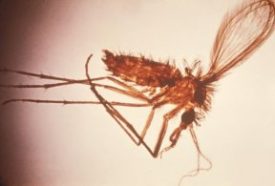Spitting Up Blobs to Get Around
A nasty parasite finds a new host by making a fly cough up a blob of gel.
The tiny bugs that can cause disease often have ingenious ways of spreading themselves around.
Now, scientists have figured out how one particular parasite does it—by forcing its host sand fly to spit up.
 |
|
Female sand flies are bloodsuckers that can carry Leishmania parasites from dogs, foxes, and other animals to humans. |
| Public Health Image Library |
First, the parasite multiplies in a sand fly’s throat, floating in a blob of gel it makes for itself. Then, when the fly bites a person, the fly spits up, depositing the gel and its cargo of parasites into the person’s bloodstream. The infection spreads rapidly.
It sounds gross, but it’s definitely effective. About 12 million people around the world are infected with different species of these parasites, known as leishmania. Some species of these single-celled organisms are lethal. Leishmania mexicana, which the scientists studied, is one of the milder forms. If the infection isn’t treated, the parasite causes skin lesions that can leave severe scars.
Leishmania mexicana takes advantage of how sand flies make a living. These flies must feed on blood, from humans or other mammals, to survive. When a sand fly bites a mammal, the fly coughs up the blob of leishmania gel into the mammal’s bloodstream, sending countless parasites on their way.
Scientists at the University of Liverpool in England wanted to find out how important the gel is for the leishmania parasite to infect its host. If there were no gel, would the parasite still invade the new host successfully? They did some tests with mice to find out.
When they injected the parasite along with the gel, skin lesions appeared quickly. But when they injected the parasite on its own, without the gel, they found that skin lesions took longer to appear.
This result suggested that something in the gel gives the parasite a boost, speeding up the process of infection. The scientists then figured out that a particular type of protein in the gel is the important ingredient. But they’re not sure exactly how this protein does its job. If researchers can work out how the protein works, it may help them design a vaccine that can combat leishmania.
A new vaccine won’t help sand flies, though. Once infected, these little critters are stuck with leishmania—and the accompanying blobs of gel—for life.—S. McDonagh
Going Deeper:
Seppa, Nathan. 2004. Parasite pursuit: Sand fly coughs up leishmania protozoan’s secrets of proliferation. Science News 166(July 24):53. Available at http://www.sciencenews.org/articles/20040724/fob6.asp .
You can get information about Leishmania and the infections this parasite causes at www.cdc.gov/ncidod/dpd/parasites/leishmania/factsht_leishmania.htm and www.dpd.cdc.gov/dpdx/HTML/Leishmaniasis.htm (Centers for Disease Control and Prevention).







